In 1998, Activision announced a 10-year deal with Viacom Entertainment for the license to produce and develop Star Trek games on multiple platforms. At the time, Deep Space Nine and Voyager were still in production and the release of Star Trek: Insurrection was just on the horizon. The publisher’s goal was clear: Building on the momentum achieved by the popularity of the shows and movies, it would finally deliver a new generation of high quality Star Trek video games that appealed to both casual fans and hardcore gamers alike.
Others had attempted this prior to Activision, and, while some came close, most failed to hit the mark. Games would often either require prior knowledge of Star Trek to be enjoyable or would feature complex gameplay systems that would turn away the more casual gamers.
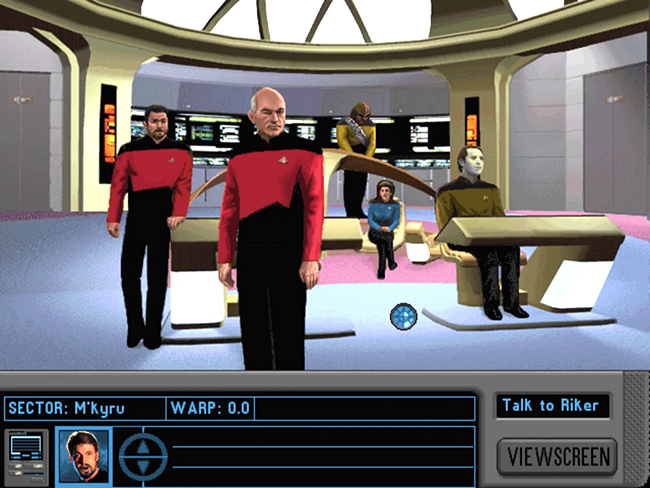
Credit: MicroProse, Paramount, Spectrum HoloByte
There were, of course, exceptions. For example, 1995’s Star Trek: TNG – A Final Unity blended a great point-and-click adventure game with an authentic Star Trek story. However, it failed to break new ground, sticking to a familiar genre with limited mainstream appeal, a trap that most Star Trek titles had fallen into at that time.
Activision certainly had its work cut out for it, but recognizing the strong presence that Star Trek retained on both TV and film, they had the wherewithal to strike while the iron was hot. By experimenting with multiple different genres, they created one of the most diverse collections of Star Trek video games, remembered fondly by fans to this day, and the likes of which have not been seen since.
Fast-forwarding to the present, Star Trek has returned to our screens in a way not seen since Activision’s deal was made. With no publisher or developer currently utilizing the Star Trek license in the way that Activision did, coupled with a games industry that is leaps and bounds ahead of what it was back then, the strategy employed by Activision over two decades ago could also be key to a new generation of Star Trek games succeeding today.
The Vision
Star Trek’s popularity as a brand, and the success of properties based on it, primarily relies on the shows and movies. There will, of course, always be fans of the older material, of which there is plenty still available on streaming services such as Netflix, allowing new audiences to discover Star Trek. But as Activision would find out—to its detriment—it’s also vital for there to be new releases, continually refreshing the franchise.
When Activision struck its licensing deal with Viacom, the Star Trek franchise was flying high, and it’s easy to see why the publisher was keen to invest in it. I, along with Chris Koerner, ran one of the biggest fan-sites (remember them?) for some of Activision’s Star Trek titles, and we witnessed the excitement surrounding Activision’s announcement firsthand. Initially a small passion project, our site quickly became a central hub where fans would go to see exclusive screenshots, read interviews, and take part in Q&A sessions with the developers, who were just as excited to speak about the games they were working on as the fans were to play them. With some help from Koerner, I even got the chance to visit one of the developers’ studios while on vacation in Boston in the summer of 2001 for an exclusive firsthand preview for the site, which only amplified my excitement. I could see for myself that the license was in good hands.
“Back in that timeframe, Star Trek as a whole was basking in the glow of great content, with The Next Generation, Deep Space Nine, Voyager, movies and more, it was fantastic!” Koerner recalled. “In turn the enthusiasm around Star Trek games was also at a fever pitch. I think I’m pretty lucky to have gotten to experience that time. The anticipation around the release of each new game was quite exciting.”
In the decade prior, Star Trek game releases had been a mixed bag. Various developers had released titles with little cohesion between them, ranging from film tie-ins to FMV-heavy “interactive movies” to even pinball simulations. Star Trek video games, up until this point, often carried the stigma of not being particularly fun. Exceptions like the aforementioned A Final Unity did exist but were rare, and the prospect of a publisher with Activision’s size and caliber committing to a decade of developing new Star Trek titles was a reason to be optimistic.
“I remember that before Activision came onto the scene I was only mildly interested in Star Trek video games,” Koerner said. “I think the scale at which Activision went in really helped grow the Trek gaming community. It felt like the Star Trek gaming community finally had a titan on their side.”
Despite not quite being the behemoth it is now, Activision had been steadily growing for many years. CEO Bobby Kotick had driven the company to make new studio acquisitions, a practice that continued well into the 2000s. Purchases included developers like Raven Software, and later, Infinity Ward, both of whom would go on to work on games for the Call of Duty series. The Star Trek deal was a part of this expansion strategy. Once the agreement was finalized, Activision wasted no time getting underway.
A Golden Era Begins
The publisher’s strategy was a bold one. Working with a varied ensemble of experienced developers, some of whom were part of the recent acquisitions, Activision set out to create a diverse collection of high-quality Star Trek games spanning many popular genres of the time, aiming to appeal to a mainstream audience. This resulted in more ambitious and modern Star Trek games than ever before, and though some were certainly better than others, the list of titles it released (shown below) certainly shows the range of genres it tackled, and the pace at which they were produced:
- 1999 – Star Trek: Hidden Evil (third-person action/adventure)
- 2000 – Star Trek: Armada (real-time strategy)
- 2000 – Star Trek: ConQuest Online (collectible card game)
- 2000 – Star Trek: Voyager – Elite Force (first-person shooter)
- 2000 – Star Trek: Invasion (space combat, third person shooter)
- 2001 – Star Trek: Away Team (2D isometric squad-based strategy)
- 2001 – Star Trek: Armada II (real-time strategy)
- 2002 – Star Trek: Bridge Commander (space combat bridge simulation)
- 2002 – Star Trek: Starfleet Command III (space combat, real time tactics)
- 2003 – Star Trek: Elite Force II (first-person shooter)
Staying true to its original goal, and by enlisting a range of talented developers who really knew and cared about Star Trek, Activision produced titles that blended credible and enjoyable gameplay with experiences that felt authentically Star Trek. Upon launching each game, players were greeted with the Activision logo “de-cloaking” in traditional Star Trek fashion, before being blown to pieces by the Enterprise (the Enterprise would be replaced with the USS Voyager in Elite Force and a Valkyrie fighter in Invasion to match the games’ respective settings). Activision wanted to set its titles apart from what had come before, and this felt like them driving that point home.
Fans were particularly excited about these games because of when they were set in the Star Trek timeline. Many past titles took place in a previously established period, usually during the era of the TV shows, but Activision’s licensing deal allowed their titles to be set in a timeline that moved forward from what had last been seen on TV and film. This meant that each game could explore events not yet established in Star Trek canon, giving the developers freedom to create their own stories.
Activision’s first release, Star Trek: Hidden Evil, was actually a direct sequel to the most recent feature film at the time, Star Trek: Insurrection, which released the previous year. The game even featured footage from the movie in its intro sequence. Developed in just one year by Presto Studios, Hidden Evil was an action/adventure game that was intended to appeal more to casual gamers, as well as to Star Trek fans who may be turned off by more difficult games.
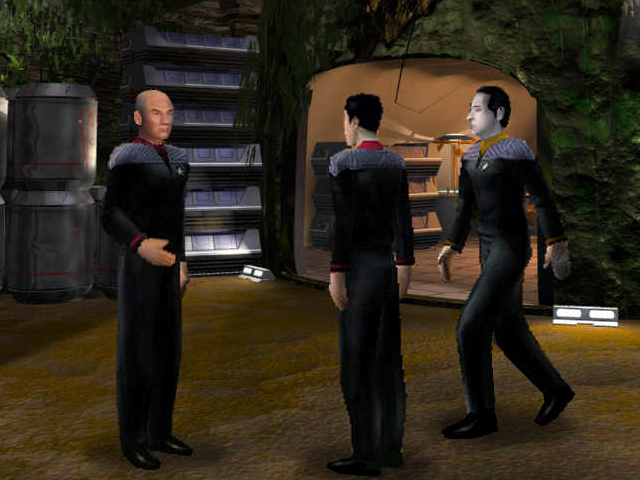
Credit: Activision, Paramount, Presto Studio
“A piece of market research out of Activision stated that, of people that own game-capable PCs and enjoy watching Star Trek, only a small fragment had ever purchased a Star Trek computer game,” Michael Saladino, Hidden Evil’s lead programmer, wrote in a postmortem shortly after the game’s release. “Number one reason as to why they had never bought one: ‘They look too difficult.’ That was our market. We wanted to give casual gamers the opportunity to be in an episode of Star Trek.”
Hidden Evil ultimately proved to be too easy for more experienced players, but it still featured gorgeous prerendered environments for the time (something that Presto Studios was known for), as well as a credible Star Trek story featuring well-known cast members. Activision had wanted to create an easily accessible first title for Star Trek fans first and foremost, and this it did. However, it merely set the stage for what was to come, and with each title released, the publisher further pushed the envelope with regards to what a Star Trek game could be, with some standout examples that accomplished this particularly well.
Real-time strategy game Star Trek: Armada released a few months after Hidden Evil and was highly anticipated, allowing players to command fleets of starships from some of Star Trek’s most well-known races and pit them against one another in combat. While Hidden Evil had ties to more traditional Star Trek games of the past, Armada sat within a hugely competitive genre at the time. RTS games had surged in popularity thanks to titles like Blizzard’s Starcraft and Westwood Studios’ Command & Conquer series. The prospect of a Star Trek game in this style had fans extremely excited.
Activision was careful to select the best studios for each game, and Armada was no exception. Mad Doc Software (now part of Rockstar Games, following a 2008 acquisition by Take Two) specialized in this style of game and assisted on Armada’s development in-house at Activision, eventually going on to fully head up development of a sequel, Armada II, the following year. Armada II expanded on many aspects of the first game, adding new ships, races, and more complex systems.
As well as solid RTS gameplay that would attract existing fans of the genre, both titles featured an extensive cast of Star Trek characters, all voiced by their TV counterparts (something that would extend to all of Activision’s Star Trek games), and featured plotlines that drew inspiration from some of Star Trek: The Next Generation’s most memorable episodes. It was a good balance and aligned perfectly with Activision’s goals of mainstream appeal.
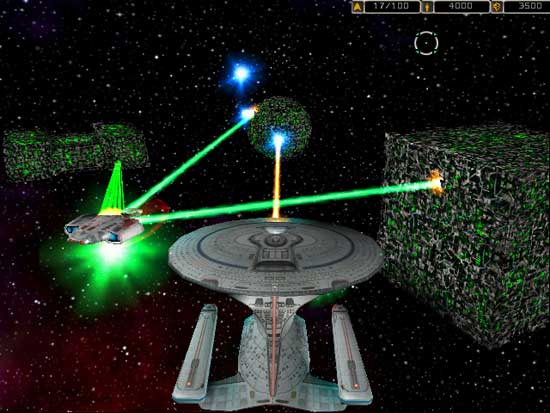
Credit: Activision, Paramount
With Hidden Evil considered too easy for more seasoned gamers the year before, and a high level of competition within the RTS genre, Armada senior producer Marc Turndorf told me the developer’s goal was to appeal to all types of gamers. “We went about this by designing with the following mantra: ‘Easy to learn and hard to master,’” Turndorf explained. “Thus casual and hardcore players alike can enjoy the game in their own way. A great example of this at the time was Tony Hawk: Pro Skater, which was great fun for casual players, but when a hardcore player mastered it, it was like they were playing the game at a whole other level. Every RTS game has this embedded in their DNA, with some players playing ‘checkers’ with the more advanced players playing ‘chess.’”
Star Trek: Armada I and II were well-received by fans and critics, especially considering the number of RTS games around at the time. The two titles remain fan favorites, with a very active modding community releasing new updates to this day. The Armada games highlighted the commitment Activision made to bringing Star Trek games into more modern genres.
Star Trek: Voyager – Elite Force further emphasized this commitment. Developed by Raven Software, who had years of experience with first-person shooters, Elite Force used the id Tech 3 engine originally developed for the hugely successful Quake III Arena. A genre often reserved for more hardcore gamers, the idea of a serious FPS set in the Star Trek universe spawned its fair share of doubters. Instead, it proved to be one of Activision’s most popular and successful releases.
From the start of development, Raven Software was careful to ensure that the game stayed true to Activision’s original mandate, Elite Force game director Brian Pelletier said. “Our two main pillars of the game was that it must ‘feel’ like a Trek experience and it must have all the FPS action of a fast-paced shooter,” he said. “We often grappled with, should it be a shooter first and Star Trek game second or Star Trek game first and shooter second?”
I asked Pelletier if he and his team ever had concerns bringing Star Trek to the FPS genre, considering its hardcore nature could turn off Star Trek fans who may be more casual gamers. “Paramount/Viacom was involved in the design process the entire way through the game’s development,” he said. “We delivered design documents for them to approve along with visuals and playable demos, etc. I went to Paramount Studios several times during production to have them playtest the work in progress game.”
Working closely with Paramount ensured that the game never strayed too far from the spirit of Star Trek while also giving the team the freedom to deliver the kind of game they were known for. “They were very open to our ideas,” Pelletier said. “I commend the Paramount team we worked with because they got the fact that we were making a shooter and encouraged us to make it a true shooter and not tone it down for Star Trek… They actually wanted us to embrace the FPS gameplay. It helped that we were not designing an excessively violent game and respected how Star Trek handled their action scenes so there wasn’t a concern.”
With the game set during the events of the Star Trek: Voyager TV series, which was still airing new episodes at the time of Elite Force’s release, the developers knew their work had to feel authentic, as it would be closely scrutinized by fans. “The team’s approach to the game was to make it feel like a day in the life of a Star Fleet Officer,” Pelletier said. “The first-person view gave us the immersion we needed to pull off an engaging experience that felt like you were in a Star Trek episode.”
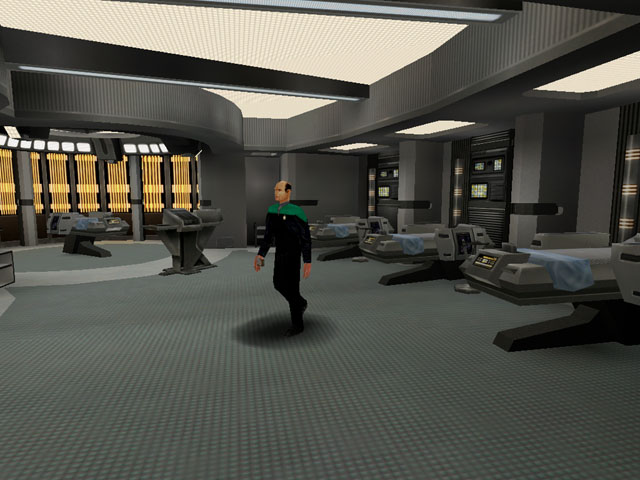
Credit: Activision, Paramount, Raven Software
Since the game faithfully and painstakingly recreates much of the USS Voyager starship, with all the well-known sights and sounds fans of the show would expect, I asked Pelletier how much access he and his team had to the official material. “Paramount was very open to giving Raven access to their Star Trek archives,” he said. “I made several trips to Paramount to discuss story and overall vision of the game and gather reference materials. There is a Trek archive room with hundreds of binders with photos of sets, the actors, props, show stills, etc., from all the Trek shows going back to the original Trek. I was like a kid in a candy store poring through the materials for what we need to be as authentic as possible. I also met with the Star Trek art department artists who ultimately helped us design the deck layouts of Voyager for the game.”
Also featuring voice acting from all of the shows’ main cast members at the time, Elite Force lived up to what the team had hoped to achieve: making the player feel as though they were in an episode of Star Trek. But it was also extremely important, especially for a FPS, that Raven nailed the gameplay as well, as the team didn’t want to alienate non-fans, and other games in the genre had set a high bar.
“Much of the Trek infusion was the down time on Voyager in between missions, where you talk with the crew, explore Voyager and get briefings,” Pelletier explained. “This was our Star Trek cerebral side of the game that made it really feel like Star Trek. There was concern it would turn hardcore gamers off to be away from the action during this long interludes.”
Pelletier and his team were careful, however, to ensure that this didn’t happen. “We created flow charts for pacing the game so that we could map out the tempo and see it visually as a timeline. And adjust timing when it was too long,” he said. “We focused away missions on pure FPS action with the NPC away team. That away team AI went through a lot of tuning as they could be too good and do the shooting for you or not good enough and they looked bad. It was a fine line we had to maneuver and took some time to get the right balance.”
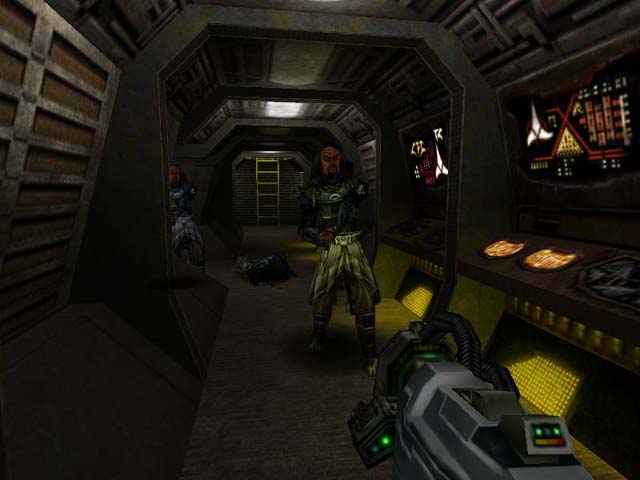
Credit: Activision, Paramount, Raven Software
Raven Software ultimately did get the balance right, as the game featured excellent FPS gameplay, as well as a multiplayer mode that was often compared to that of Quake III Arena—extremely high praise at the time. Elite Force went on to win over both fans and critics alike upon its release, being a prime example of a Star Trek game that could stand toe-to-toe with the best of its genre. Today, it’s widely considered one of the best Star Trek games ever made. “I remember reading a review of the game that went something like, don’t let the Star Trek name fool you,” Pelletier recalled. “Yes, it is everything Star Trek fans love but even if you’re not a fan, this is a great shooter game at its core.”
The Console Frontier
Having mainly been targeting the PC market thus far, Activision saw an opportunity to reach an even wider audience with Star Trek: Invasion, which would release exclusively on the Sony PlayStation. In the past, the majority of Star Trek games were tailored to the strengths of PCs, but developer Warthog Games went a different route with Invasion, allowing the player to command small, speedy fighters in fast-paced arcade gameplay that was a perfect fit for console controls.
“I have a traditionally ‘action-orientated’ background,” said Haydn Dalton, Invasion’s lead designer, “and the other key members of the team… were both ex-Psygnosis and Colony Wars people with great [PlayStation] knowledge,” “Doing a more action-focused Star Trek game seemed a natural fit for myself, the team and the platform.”
Invasion featured a similar style of design and gameplay as the popular Colony Wars series on the PlayStation, and the team at Warthog wanted to ensure, rather than simply applying a Star Trek “skin,” that they did the name justice. “Any time you do a game using a beloved franchise, you’re walking a tightrope,” Dalton told me. “Context, setting, story, characters, game mechanics, audio, etc., they’re all very considered choices for us, as we know they’ll be scrutinized. I knew I could never please everyone, but if we could make something that the majority of Star Trek–loving, PSX-owning players (including myself) could enjoy, that felt like a good goal.”
With Invasion featuring fast paced, action-oriented gameplay, Dalton and the team had to make sure—considering Star Trek’s message is largely focused on peace—that it was justified. “The aggressive nature of what I wanted to do was strongly against what the Prime Directive is all about,” explained Dalton, “so I had to create a threat so great that the Federation would be pressured to explore an alternate effort to counter the problem or face losing everything.”

Credit: Activision, Paramount, Warthog Games; via MobyGames user BurningStickMan
That threat was the Kam’Jahtae, an insect-like alien race descended from an ancient Klingon enemy called the Hur’q. After being accidentally awakened, they present a threat to the Federation—and the galaxy—that eclipses that of even the Borg. Depending on player actions in the game’s final mission, there is also the possibility of three different endings, ranging from complete success, to a unique (for Star Trek) “bad” ending, with Captain Picard declaring to players, “It is my only hope that we can find a way to defeat this vicious new enemy, so that the sacrifices of those who died were not in vain…”
To further ensure the game’s storyline felt authentic to Star Trek fans, Dalton tells me that best-selling author James “Jim” Swallow was brought in to help out, having also previously worked on a couple of Star Trek: Voyager scripts. “Jim had written a couple of Star Trek books and was also working for Star Trek Monthly, if my memory serves me right.” said Dalton. “Once Jim came on board, I sent him all the written work I’d done for the missions, dialogue, etc., and once I started getting samples back from him, he’d transformed it from a Star Trek–themed game to an authentic, legitimate piece of Star Trek fiction. He did an amazing job, so much so, that I had him hired again for a game I did a few years later.”
Star Trek: Invasion was popular amongst both fans and critics upon its release, with IGN’s Douglass C. Perry saying in his review at the time that for “hardcore Star Trek fans this game should finally put to rest the idea that a Star Trek game can’t be made for consoles.”
Once again, Activision’s willingness to experiment with the Star Trek license, taking it to places it hadn’t been before, paid off.
On the Bridge
Making players feel as though they were taking part in an episode of Star Trek was a goal for many of Activision’s Star Trek titles. This meant that players had to feel immersed in the world they were presented with, and having people working on each game that were passionate about Star Trek was key to delivering these kinds of experiences. Another crucial component of this was telling meaningful and engaging stories in each game, something that has always been of prime importance to the success and popularity of the franchise.
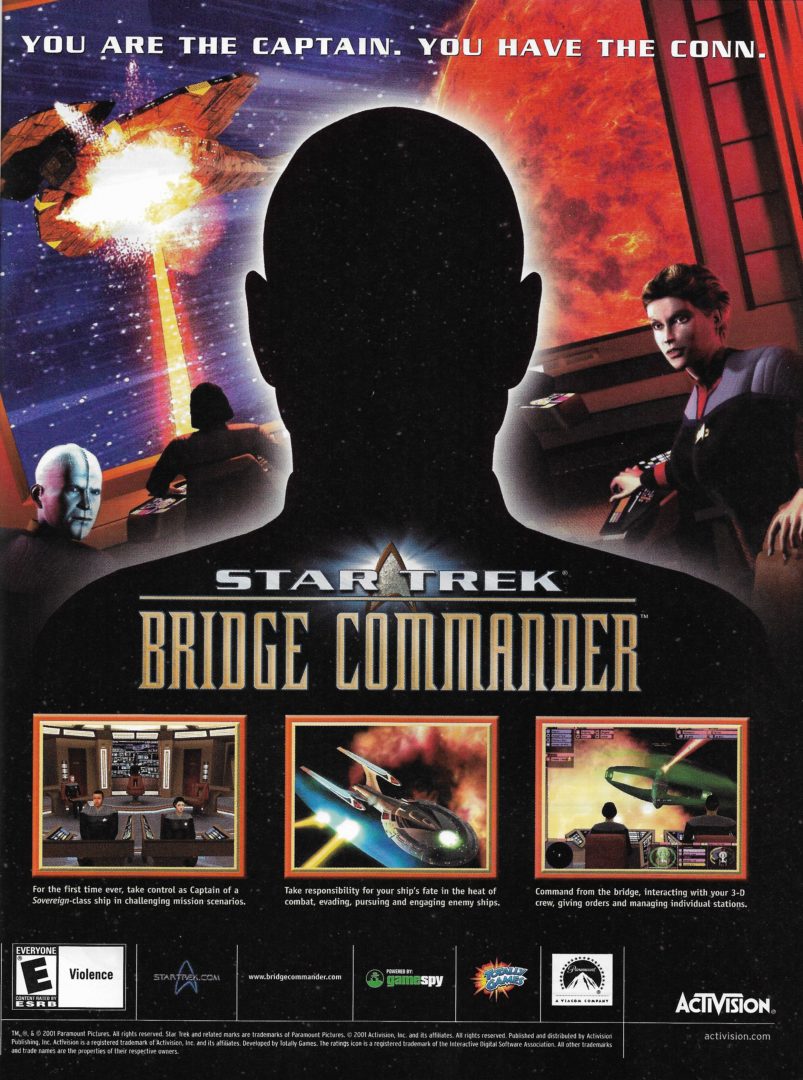
Credit: Activision, Paramount; via MobyGames user Kabushi.
Star Trek: Bridge Commander, the eighth Star Trek title released by Activision, is a perfect example of this philosophy in action. One of the more ambitious titles that Activision published, Bridge Commander, developed by Totally Games, put the player in the captain’s chair on a fully realized 3D starship bridge and featured the more tactical, cerebral space combat that Star Trek was known for.
While most of Activision’s previous Star Trek games focused on delivering gameplay experiences that pleased fans of their respective genres, Bridge Commander was all about immersion. “It had to be the most compelling Star Trek experience (I use the word experience because we were shooting for something more than just a game),” said senior producer Parker A. Davis. “That would allow players to live out their fantasies of being in the shows, on the ship, in command and facing the same kind of challenges their heroes from Star Trek always faced.”
A large part of this was delivering a solid Star Trek story to the players, and Davis told me the team felt the weight of that expectation. “I think the pressure came from within ourselves,” he said. “Because of the pride we felt in having such a phenomenal opportunity, the love and reverence we had for the Star Trek universe, and the passion we had for pulling off the challenging vision of such a genre defining game. We set incredibly high standards for quality that guided everything that went into the game, and we relied on the wonderful talents of the actual stars and writers of Star Trek to stay on course and bring it home.”
To help meet these high standards, Davis and the team enlisted the help of Star Trek royalty. “We knew we needed to bring in the biggest guns to craft a story worthy of these audacious goals,” Davis told me. “So it was a coup to be able to engage Dorothy Fontana, one of the writers of some of the most iconic TOS [The Original Series] episodes, and her mentee and co-writer Derek Chester, who was a virtual encyclopedia of Star Trek lore and canon… We met and brainstormed regularly and the storyline and plot points emerged and evolved. Then it was just a matter of filling in the details as the writers crafted the dialogue that would bring it all to life.”
As a result, Bridge Commander’s story feels decidedly more like a multi-episode arc of Star Trek than previous games. Beginning with a star going supernova and the death of your captain, Bridge Commander then puts the player in control of the USS Dauntless, a Galaxy-class starship, to open an investigation into the star’s destruction. Later taking command of the USS Sovereign, the Enterprise-E’s sister ship, you uncover the involvement of an alien race called the Kessok, who, having allied with the Cardassians, drag the Federation into war, which ultimately leads to a Federation-Klingon-Romulan alliance, similar to the one previously seen in Deep Space Nine’s final seasons.
The game’s chapters take the player on a variety of different missions, from more mundane tasks such as scanning asteroids to dramatic space combat complete with exploding consoles and “camera shake” effects. In classic Star Trek fashion, Bridge Commander’s final mission presents the player with the option to either resolve things peacefully by hailing an enemy ship, or to open fire, resulting in the mission playing out differently depending on which choice you make.
Further adding to the immersive nature of Bridge Commander was the use of Patrick Stewart and Brent Spiner, reprising their roles as Captain Jean-Luc Picard and Commander Data. They often feature in missions and even, on occasion, accompany the player on the bridge. It was a somewhat surreal experience as a player, to be in the captain’s chair of a starship, turn to the left, and see Captain Picard sitting next to you.

Credit: Activision, Paramount, Totally Games; via MobyGames user Entorphane
Stewart and Spiner were part of an impressive list of familiar cast members who lent their voices and likenesses to Activision’s Star Trek titles, including Michael Dorn (Worf), Kate Mulgrew (Captain Janeway), Jeri Ryan (Seven of Nine) and John de Lancie (Q), amongst many others.
“I smile every time I think of it,” said Davis of working with Patrick Stewart and Brent Spiner on Bridge Commander. “And I have to say it was not only one of the highlights of my career, but one of the highlights of my life.”
The well-known Star Trek cast are an integral pillar of the franchise, especially to fans. Davis, as both a fan and a contributor, was hugely impressed with how seriously they treated being a part of the project, and the respect they had for their characters, which only added to the sense of authenticity found in Bridge Commander.
“It was an amazing experience to watch them ply their craft and bring the characters, their characters, to life right in front of our eyes,” Davis said. “To watch them perform in such close proximity was to see first-hand and appreciate their incredible skill, command of their characters, personal charm, quick wit, humor and acting subtleties. Patrick Stewart was the consummate professional, as expected, with a gentle charm that belied the strength of his command. Brent Spiner was himself a real character, full of personality and exuberance, and made us laugh throughout. Tapping into all this was hugely important to delivering an authentic Star Trek experience. We weren’t just making some offshoot, we were making a genuine, full blown and completely authentic Star Trek show… experience… thing. And not only that, we thought it might be pretty good.”
Bridge Commander turned out to be more than “pretty good,” providing players with one of the most immersive and genuine Star Trek video game experiences ever developed. GameSpot’s review called it “the first Star Trek space sim that actually feels like it’s set in the Star Trek universe.”
Davis and his team’s passion for Star Trek, and the care in which they handled production, is something that rang true for each game that Activision published, ensuring that the end results remained true to the franchise. Still the developers weren’t completely trapped within the confines of the established Star Trek universe. Each development team had the creative freedom to introduce new ideas, concepts, and characters with every title they produced. Elite Force, for example, introduced us to the Hazard Team, a group of specialized security officers set up and trained by Commander Tuvok to be used for extreme missions, while Invasion saw the introduction of Red Squad, a team of elite fighter pilots stationed aboard the USS Typhon, a specialized carrier ship led by Lieutenant Commander Worf.
To Boldly Go
Activision published a number of other Star Trek titles during its time with the license that, while not being quite as successful as the ones mentioned so far, still brought Star Trek to new genres and continued to go against the preconceived notions of what a Star Trek game could be. Reflexive Entertainment gave us a different spin on traditional Star Trek “away missions” with Star Trek: Away Team, giving the player control of a team of specialist Starfleet infiltrators in 2D isometric strategy gameplay, similar to titles like 1998’s Police Quest: SWAT 2 and Commandos: Behind Enemy Lines.
Alongside developer Genetic Anomalies, Activision even tried its hand at an online-only collectible card game with Star Trek: ConQuest Online. Online-only gaming was very much in its infancy when the game launched 20 years ago, so it was a bold move by Activision to invest in the space so early on.
One of the last titles that Activision produced with the Star Trek license was the real-time tactics game Star Trek: Starfleet Command III. With the previous titles in the series published by Interplay Entertainment, Activision recognized the popularity of the series and brought back developer Taldren to work on this installment, moving from the Original Series setting of the previous games to a timeline set that tied in with the events of Star Trek: Nemesis, due to be released the following year.

Credit: Activision, Paramount, Taldren; via MobyGames user BurningStickMan
Covering such a diverse range of genres while also balancing gameplay concerns with respect for the source material, Activision’s titles had brought Star Trek games to a mainstream audience. For fans of Star Trek in particular, the period in which Activision held the license is widely considered a golden era for Star Trek games. “I remember the message boards having loads of activity around any news that was released for Star Trek related video games.” Koerner recalled. “From guesses on what barely visible bits in a screen shot could be, to deep discussions on possible features and single player missions, across multiple boards on multiple sites. It was pretty amazing!”
Even if a particular game didn’t connect with you, another was always around the corner. Had Star Trek maintained its presence on TV and film—something which Activision was relying on to help drive interest in the games they were developing—we may have seen much more from them. Unfortunately, this was not to be the case.
Dropping Out of Warp
Activision published a total of 10 Star Trek games in the first five years of the original deal. However, in mid-2003, Activision terminated its agreement with Viacom and filed a lawsuit, claiming that Viacom had let the Star Trek franchise “stagnate and decay” by not investing in new TV shows and movies. Activision may have had a point. By the time the two sides had reached a settlement in 2005, there had not been a Star Trek movie release since 2002’s poorly reviewed Star Trek: Nemesis. Nemesis also marked the clear end for a storytelling arc for Captain Picard and the Enterprise crew, who had been a huge part of Activision’s licensing deal.
There were no plans for any other movies in the works and, in 2005, Enterprise, the only Star Trek show then airing new episodes (Deep Space Nine and Voyager had ended in 1999 and 2001, respectively) was cancelled after its fourth season. For the first time in 18 years, no new Star Trek content was being produced. This was in stark contrast to the situation seven years earlier, when the deal was made and the brand was at its height. Activision felt there was diminishing value in the license they had acquired.
The last Star Trek title released by Activision was 2003’s Star Trek: Elite Force II, a sequel to one of its most popular and successful Star Trek games. With Raven Software busy—working with the opposition on Star Wars games, no less—development was handed over to Ritual Entertainment, with the game moving from the Voyager setting of the original to that of the Enterprise-E. Its story followed on from Voyager’s return to earth and loosely tied into the events of Nemesis.
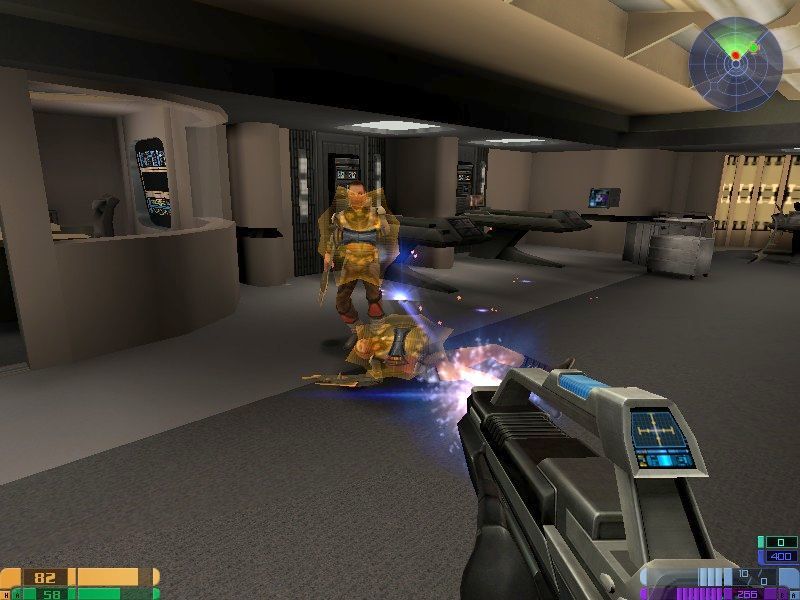
Credit: Activision, Paramount, Ritual Entertainment; via MobyGames user ClydeFrog
Christopher Stockman, the game director on Elite Force II, told me that the team “had created a premise where Starfleet Academy in San Francisco was attacked by a group of terrorists (shades of Khan and his group of genetically enhanced peeps), but then 9/11 happened and Paramount thought the story hit a little too close to home, so to speak, so it was altered to include Exomorphs and Romulans and Ferengi (oh my!).”
That turned out to be the least of the game’s troubles, however: Despite expanding on many aspects of the original, and being generally well received, Activision’s termination of its deal with Viacom happened mere weeks after Elite Force II’s release, meaning that the game would not be supported at all, with copies of the game even subsequently being pulled from store shelves.
The sudden termination of the agreement caught many off guard, with multiple developers having already begun working on ideas for future Star Trek games for Activision. “I left Ritual just as the game went Gold,” Stockman said, “but I do know they were doing preliminary work on Elite Force III with the Doom 3 engine.”
Invasion’s Haydn Dalton also told me about an idea that he and the game’s art director pitched to Activision, a follow-up to Invasion code-named “Project Oblivion” that would have come to the PlayStation 2.
“This was to be a multiplayer (up to 4 players) space-sim action game,” Dalton told me, “with a lot of emphasis on co-op and next-gen features, such as online play, adapting Valkyries, personalized weapons, voice controlled features and space-to-ground transitions.” Dalton even had some ideas for online features that were, especially on a console, ahead of their time. “One thing that I wanted to do, was also create an ‘Online Academy,’ where Oblivion players could discuss, share and team up for missions, [and] get new objectives.”
After Activision’s deal with Viacom broke down, Bethesda Softworks picked up the license in early 2006 and released four Star Trek games by 2007, focusing mainly on the console market. Interestingly, one of the first titles they released was a game called Star Trek: Legacy, which was developed by Mad Doc Software, the same team behind the Armada titles with Activision. Legacy even used the same engine. Chris Koerner, after working closely with much of the development team during his time on the fan site, actually went on to work as a developer on Legacy.
However Bethesda’s titles failed to find much of an audience, possibly because they were spread thinly across different platforms with no overlap between each title, making it difficult for players to become invested in the full range of titles. The publisher hasn’t released a Star Trek game since.
Since then, J.J. Abrams’ Star Trek “reboot” movies, the first of which released in 2009, brought with them a couple of movie tie-in games that weren’t received particularly well, and there have also been a handful of smaller browser and iOS based Star Trek games released by various developers in recent years. In 2010, Cryptic Studios launched Star Trek: Online, a fully fledged MMORPG that’s still supported to this day, and in 2016 Ubisoft released Star Trek: Bridge Crew, a VR game. Despite these titles finding some success, however, we’ve yet to see a publisher commit to the broad development of new Star Trek games the way Activision did two decades ago.
Should anybody be willing to take the risk now?
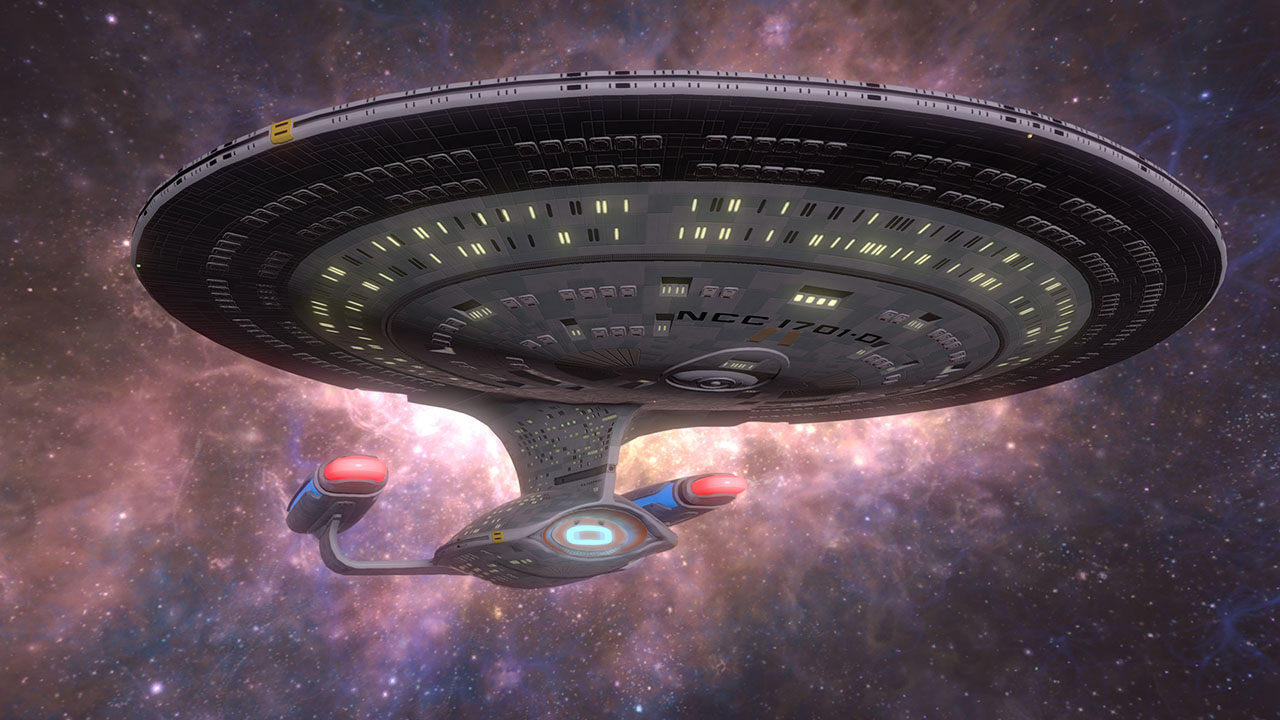
Credit: Ubisoft, Paramount
Discovering New Life
Star Trek has been experiencing something of a renaissance in recent years. Although the brand was very popular when Activision secured the license in the late ’90s, its mainstream presence and appeal is arguably larger now than it was then. Despite having two concurrently running shows on TV in 1998, Deep Space Nine was approaching its final season, and Voyager’s viewing figures were lower than the shows that preceded it.
In contrast, Star Trek: Discovery, is on the opposite trajectory due to launch its third season later this year and already renewed for a fourth. Discovery hasn’t only appealed to existing Star Trek fans but also found an audience in those new to the franchise. Its success paved the way for a spin-off (starring Michelle Yeoh and focused around the shadowy organization Section 31) and also led to Patrick Stewart reprising his most well known role as Jean-Luc Picard in the just-premiered Star Trek: Picard, which has now been officially confirmed for a second season. There are also two new Star Trek animated shows entering production, one being developed by Mike McMahan (Rick and Morty), and the other a CG-animated show for Nickelodeon. There is even more Star Trek content in the works as well, with Alex Kurtzman, executive producer on both Discovery and Picard recently revealing that there are two more live-action Star Trek shows in development.
With the franchise healthier than it has been for a long time, combined with a renewed appetite for Star Trek, and with plans in place to grow even further in the years to come, the timing seems perfect, once again, for the development of new Star Trek games.
The Next Generation
Games today are bigger, more expansive and more ambitious than ever before, featuring fully explorable (literal) universes, as well as richly detailed terrestrial environments for players to traverse, and as the games have grown, so too has the player base. While part of Activision’s goal was to convert those who may not already be video game fans, today, many are waiting with bated breath for new Star Trek titles to take advantage of the industry’s growth. Were a publisher or developer to secure long term rights to produce Star Trek games once again, employing a similar strategy to Activision’s own, covering multiple different genres and game styles, could prove more effective today.
“For a Star Trek game to be successful, you have to create a fun and engaging experience that doesn’t isolate non–Star Trek fans,” Invasion’s Haydn Dalton said. “This universe allows us to tell simple stories within an amazing context, so present that to developers and it’ll open clear routes for action-adventures, RPGs, RTS, and so much more. I do believe Star Trek could make a big surge back if the right development teams were given the time and budget to do them justice.”
Activision also had great success with Star Trek first-person shooters. With the genre now more popular than ever, there’s no reason why that success couldn’t be repeated. “I totally believe a Star Trek shooter is viable in the current landscape of shooters,” Elite Force’s Brian Pelletier said. “I personally would like to see a campaign style narrative co-op FPS experience, with a great cerebral storyline, familiar settings, enemies, characters and ships, along with an asymmetrical multiplayer battle mode with different alien factions all with their own motives for winning outcomes.”
While these different genres would lend themselves well to Star Trek games today, it’s not just the gameplay that’s important. Story has always been an integral part of what makes for an authentic Star Trek experience, and the last decade in particular has seen video games storytelling reach incredible new heights with titles like The Last of Us, God of War and Red Dead Redemption 2.
Bridge Commander’s Parker A. Davis feels particularly passionate about this aspect of Star Trek. “I think the future of Star Trek games is somewhat tied to its past, in a good way,” he said. “That is, it’s got to always be about letting the player live the core fantasy of Star Trek, whether it’s commanding a ship from the bridge, a fleet from a strategic vantage point, or an away team on a dangerous mission of exploration.”
Most important of all is Star Trek’s message. “To carry on the mantle of Star Trek it has to be aspirational and human, portraying the gravest stakes against a background of hope for the future. That’s the core fantasy—being human and using that to overcome anything the universe can throw at you,” Davis said.
“It’s also about Tribbles,” he added.
Header image credit: Star Trek: Armada II promotional art; Activision, Paramount, Mad Doc Software
Correction: An earlier version of this post identified Haydn Dalton as Star Trek: Invasion’s lead programmer. He was the lead designer.

Steve Kaye is a lifelong fan of video games and Star Trek from London, England, who also enjoys music production, going to the gym, watching American Football and stereotypically drinking lots of tea while discussing the intricacies of life with friends. Follow him on Twitter @SteveKaye84.